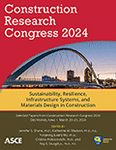Equity-Integrated Infrastructure Resilience Analysis: Case Studies of Florida Communities
Publication: Construction Research Congress 2024
ABSTRACT
To mitigate the impacts of climate change on infrastructure, there has been a growing trend toward adopting resilience strategies in infrastructure planning. However, research highlights historical discriminatory practices and biases in policies and investments, resulting in disproportionate disaster impacts on communities. To effectively evaluate infrastructure resilience, it is crucial to consider these disparities. To address this need, this study focuses on assessing infrastructure resilience while incorporating disaster inequality and disaster vulnerability using a proposed equity-integrated resilience evaluation model. The resilience of infrastructure in Florida counties with different characteristics (e.g., spatial, demographic, and socioeconomic statuses) was evaluated and compared. The findings reveal that (1) the more socially vulnerable counties experienced greater disaster inequality, (2) there is a higher percentage of disaster vulnerable counties in the rural group in high-intensity hurricanes, and (3) the infrastructure of the inland counties, collectively, has weaker resilience compared to coastal ones.
Get full access to this article
View all available purchase options and get full access to this chapter.
REFERENCES
Atkinson, A., and Brandolini, A. 2010. “On analyzing the world distribution of income.” World Bank Econ. Rev., 24 (1), 1–37.
Burgess, B. 2018. “Hurricane Michael Sends Up Red Flags for The Future of Emergency Responder Communications in Florida” Accessed Sep 12, 2022. https://thecapitolist.com/hurricane-michael-sends-up-red-flags-for-the-future-ofemergency-responder-communications-in-florida/.
CDC/ASTDR (Center for Disease Control/Agency for Toxic Substances and Disease Registry). 2023. “CDC/ASTDR social vulnerability index” Accessed Feb 10, 2023. https://www.atsdr.cdc.gov/placeandhealth/svi/index.html.
Chan, R., and Schofer, J. L. 2016. “Measuring transportation system resilience: Response of rail transit to weather disruptions.” Natural Hazards Review, 17(1), 05015004.
Dhakal, S., and Zhang, L. 2023. “A Social Welfare–Based Infrastructure Resilience Assessment Framework: Toward Equitable Resilience for Infrastructure Development.” Natural Hazards Review, 24(1), 04022043.
Emrich, C. T., Tate, E., Larson, S. E., and Zhou, Y. 2019. “Measuring social equity in flood recovery funding.” Environmental Hazards, 19(3), 228–250.
FCC (Federal Communications Commission). 2018. “Communication status report for areas impacted by Hurricane Michael.” Accessed July 10, 2023. https://docs.fcc.gov/public/attachments/DOC-354510A1.pdf.
FDEP (Florida Department of Environmental Pollution). 2023. “Public Notice of Pollution”. Accessed July 10, 2023. https://floridadep.gov/pollutionnotice.
FPSC (Florida Public Service Commission). 2023. “Hurricane season power outage reports.” Accessed July 10, 2023. https://www.psc.state.fl.us/hurricane-report.
Kapucu, N., Hawkins, C. V., and Rivera, F. I. 2013. “Disaster preparedness and resilience for rural communities.” Risk, Hazards and Crisis in Public Policy, 4(4), 215–233.
Kim, J. H., and Sutley, E. J. 2021. “Implementation of social equity metrics in an engineering-based framework for distributing disaster resources.” International Journal of Disaster Risk Reduction, 64, 102485.
Moens, J. 2022. “Hurricane Michael Hit the Florida Panhandle in 2018 With 155 MPH Winds. Some Black and Low-Income Neighborhoods Still Haven’t Recovered” Accessed Feb 15, 2023. https://insideclimatenews.org/news/22032022/hurricane-michael-black-low-income-neighborhoods/.
NASEM (National Academies of Sciences, Engineering, and Medicine). 2022. Equitable and Resilient Infrastructure Investments Washington, DC, The National Academies Press. https://doi.org/10.17226/26633.
NCSL (National Conference of State Legislatures). 2020. “Challenges Facing Rural Communities” Accessed Jan 05, 2023. https://www.ncsl.org/research/agriculture-and-rural-development/challenges-facing-ruralcommunities.aspx#:~:text=Rural%20communities%20face%20challenges%20related,and%20environment%20and%20community%20preservation.
Nexus. 2017. “Hurricane Harvey hit low-income communities hardest” Accessed Feb 05, 2023. https://archive.thinkprogress.org/hurricane-harvey-hit-low-income-communitieshardest-d13506b7e60/.
NOAA (National Oceanic and Atmospheric Administration). 2018. “Hurricane Irma”, National Hurricane Center, Tropical Cyclone Report. Accessed Feb 14, 2023. https://www.nhc.noaa.gov/data/tcr/AL112017_Irma.pdf.
NOAA (National Oceanic and Atmospheric Administration). 2019. “Hurricane Michael”, National Hurricane Center, Tropical Cyclone Report. Accessed Feb 14, 2023. https://www.nhc.noaa.gov/data/tcr/AL142018_Michael.pdf.
NOAA (National Oceanic and Atmospheric Administration). 2021a. “Hurricane Sally”, National Hurricane Center, Tropical Cyclone Report. Accessed Feb 16, 2023. https://www.nhc.noaa.gov/data/tcr/AL192020_Sally.pdf.
NOAA (National Oceanic and Atmospheric Administration). 2021b. “Define Coastal Counties” Accessed June 10, 2022. https://coast.noaa.gov/digitalcoast/training/definingcoastal-counties.html.
Ouyang, M., and Duenas-Osorio, L. 2014. “Multi-dimensional hurricane resilience assessment of electric power systems.” Structural Safety, 48, 15–24.
Pagano, A., Sweetapple, C., Farmani, R., Giordano, R., and Butler, D. 2019. “Water distribution networks resilience analysis: A comparison between graph theory-based approaches and global resilience analysis.” Water Resources Management, 33(8), 2925–2940.
Raizner. 2021. “Why Hurricanes Pose Property Damage Concerns For Inland Communities?” Accessed July 10, 2022. https://www.raiznerlaw.com/blog/why-hurricanes-poseproperty-damage-concerns-for-inland-communities/.
Rao, K. D., Makimoto, S., Peters, M., Leung, G. M., Bloom, G., and Katsuma, Y. 2019. “Vulnerable Populations and Universal Health Coverage.” Leave No One Behind: Time for Specifics on the Sustainable Development Goals. Brookings Institution Press, Washington, DC.
SAMSHA (Substance Abuse and Mental Health Services Association). 2017. “Greater Impact : How Disasters Affect People of Low Socioeconomic Status”, Supplemental Research Bulletin, Disaster Technical Assistance Center. Accessed Feb 15, 2023. https://www.samhsa.gov/sites/default/files/dtac/srb-low-ses_2.pdf.
Saunders, J. 2020. “Hurricane Sally estimated to have cost Gulf Power $200 million to restore electricity” Accessed Sep 10, 2022. https://www.pnj.com/story/news/2020/10/21/hurricane-sally-estimated-have-cost-gulfpower-200-million-restore-electricity/3717578001/.
Tonn, G., Czajkowski, J., Kunreuther, H., Angotti, K., and Gelman, K. 2020. “Measuring transportation infrastructure resilience: Case study with Amtrak.” Journal of Infrastructure Systems, 26(1), 05020001.
Yabe, T., and Ukkusuri, S. V. 2020. “Effects of income inequality on evacuation, reentry and segregation after disasters.” Transportation research part D: transport and environment, 82, 102260.
Yang, Y., Tang, W., Liu, Y., Xin, Y., and Wu, Q. 2018. “Quantitative resilience assessment for power transmission systems under typhoon weather.” IEEE Access, 6, 40747–40756.
Information & Authors
Information
Published In
History
Published online: Mar 18, 2024
Authors
Metrics & Citations
Metrics
Citations
Download citation
If you have the appropriate software installed, you can download article citation data to the citation manager of your choice. Simply select your manager software from the list below and click Download.
